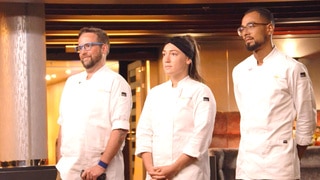
Create a free profile to get unlimited access to exclusive videos, sweepstakes, and more!
Harold Dieterle Dishes on His First Cookbook
Exclusive: get mouth-watering recipes from the 'Top Chef' winner's 'Kitchen Notebook.'

Since winning the very first season of Top Chef in 2005, Harold Dieterle hasn't been resting on his laurels. He's become one of the nation's most celebrated and recognized chefs, and has overseen a successful New York City restaurant empire that includes the Kin Shop, Perilla, and the Marrow.
So what are the secrets to his amazing rise to the top of the culinary food chain? Harold is finally telling all in his very first cookbook Kitchen Notebook, out this week (and available here). It's been a labor of love for the New York native: he spent two-and-a-half years compiling the book's recipes, which were recorded and edited in a leather bound notebook that he carries with him everywhere.
"I generally write when I'm on vacation or on the subway in New York," Harold tells the Dish. "Pretty much whenever I get inspired or have free time to myself."
The book—which features hundreds Harold's favorite of recipes, tips and techniques—features mouth-watering dishes like Turducken Lasagna, Thai Style Fried Chicken with Sweet Lime-Fish Sauce, Pancetta-Wrapped Pork Tenderloin—plus easy-to-follow recipes for cuisine staples and techniques like risotto, brining and more.
In honor of his first cookbook, the Dish caught up with Harold to discuss the process of making the book—and he's also sharing two of his favorite recipes (below).
How long did it take you to write/test this cookbook? The book took about two-and-a-half years start to finish. One of the biggest challenges when it came to testing was the seasonal availability of ingredients. We tested all the recipes in about 2 months...We had to get creative with some ingredients that weren’t available in the fall/winter.
Who was your favorite test subject to serve these dishes to? Any crazy stories from behind-the-scenes? The cooks in the kitchens at Perilla and Kin Shop got to taste everything that was made and it was good getting feedback from the team. The only crazy thing that happened while testing was the amount of brandy we used to flame out the lobster bisque almost burnt my prep kitchen down.
For budding foodies, which dishes are the easiest to prepare? Definitely all the braise dishes. There is something very rewarding about braising meat for 2-4 hours & having an amazing finished product.
Any plans to expand your empire?
Maybe, only time will tell.
Tomato Sauce
Adapted from my family’s recipe, this is a useful, all-purpose tomato sauce to have in your repertoire. Like my family, I make it with canned tomato, garlic, fennel seed, and no tomato paste. Unlike them, I don’t cook it all day—just about 30 minutes to keep the flavors fresh and bright.
Makes about 5 cups
2 tablespoons extra-virgin olive oil
2 tablespoons thinly sliced garlic
½ cup minced Spanish onion
2 teaspoons fennel seeds
1 quart whole canned plum tomatoes, with their juices
2 cups stock, preferable homemade
Kosher salt
Freshly ground white pepper
Heat the oil in a large pot over medium-high heat. When the oil is shimmering, add the garlic, onion, and fennel seeds and cook, stirring with a wooden spoon, until softened but not browned, about 3 minutes.
Add the tomatoes and stock, and season with salt and pepper. Bring to a boil over high heat. Lower the heat so the liquid is simmering, and continue to simmer until slightly thickened and intensely flavored, about 30 minutes. Taste, and adjust the seasoning with salt if necessary.
Remove the pot from the heat, and purée the sauce with an immersion blender, in a food processor or blender, or by passing it through a food mill.
The cause can be refrigerated in an airtight container for up to 3 days or frozen for up to 2 months.
All-Purpose Pasta Sauce
This is a reliable, everyday pasta sauce. You can augment it with sautéed ground beef, make it with fresh tomatoes instead of canned, alter the amount of garlic or fennel seeds, or spice it up with crushed red pepper flakes. Experiment and make it your own.
Spicy Tomato Sauce
Add 1 tablespoon crushed red pepper flakes along with the garlic, onion, and fennel seeds.
Parmigiano Sandwiches
For a Parmigiano sandwich (the name means “topped with cheese,” not necessarily Permesan), top fried eggplant or boneless chicken with the sauce, set it on a split Italian hero or other roll, top it with slices of mozzarella, and melt under the broiler.
Spicy Tomato and Shellfish Soup
Turn this sauce into a soup by adding 2 to 3 cups more stock and a total of 8 ounces crabmeat, peeled shrimp, and/or shucked scallops. Add the shrimp and/or scallops for the final 5 minutes of cooking, poaching them in the soup; fold the crabmeat in just before removing the soup from the heat.
Shellfish Pasta
This sauce is good with more than just crab. Add 8 ounces poached by scallops; diced poached sea scallops; poached or sautéed shrimp; chopped cooked lobster meat; or a combination to this sauce and toss with cooked tubular pasta such as bucatini.

Spaghetti with Crab Fra Diavolo and Toasted Bread Crumbs
Serves 6 as an appetizer or 4 as a main course
Tomato sauce and seafood were a constant presence when I was growing up in a half-Italian household on coastal Long island. One of my favorite marriages of the two was this dish my mother used to make, often with crabs that I had caught at popular crabbing locations such as Bergen Point, Captree State Park, and Tanner Park. This dish really shows off the value of a notebook-based approach to cooking: the sauce is adapted from my family’s own; the pasta can be purchased fresh or dried or can be homemade; and the bread crumbs are a versatile finishing element you can use on everything from gratins to casseroles to pastas, braised meats, salads, and roasted vegetables.
Kosher salt
4 cups spicy tomato sauce, made with seafood stock (see Notebook entry)
1 pound spaghetti, dried, fresh, or homemade
8 ounces peekytoe or jumbo lump crabmeat
6 large basil leaves, torn by hand toasted bread crumbs (below)
Small piece of pecorino Romano cheese, for grating
Bring a large pot of salted water to a boil. Put the sauce in a separate large pot and heat it gently over medium heat while you cook the pasta, allowing the sauce to simmer but not boil.
Add the pasta to the boiling water and cook until al dente, about 2 minutes for fresh or 8 minutes for dried. Meanwhile, stir the crabmeat into the sauce. Drain the pasta in a colander and add to the pot with the sauce. Add the basil and toss.
Divide among 4 to 6 plates or wide, shallow bowls, top each serving with bread crumbs and grated cheese, and serve.
Toasted Bread Crumbs
Makes about ¼ cup
1 tablespoon unsalted butter
¼ cup panko or unseasoned dried bread crumbs
2 teaspoons crushed red pepper flakes
Kosher salt
Freshly ground white pepper
Melt the butter in a wide, heavy sauté pan over medium-high heat. When the butter is melted, add the panko and red pepper flakes. Season generously with salt and white pepper. Cook, tossing or stirring with a wooden spoon, until the bread crumbs are lightly golden, about 5 minutes.

HD Caesar Salad
Serves 4
This is my version of a Caesar salad, which is my favorite salad to eat for its crunch and the powerful flavors of anchovy, Parmigiano, and cracked black pepper. I prefer oil-packed anchovy filets to salt-packed for this dish because you can replace a portion of the oil in the dressing with the anchovy oil to up the flavor.
2 large egg yolks
1 tablespoon freshly squeezed lemon juice
2 anchovy filets, preferably packed in oil
1 tablespoon Worcestershire sauce
½ tablespoon freshly cracked black pepper, plus more for seasoning
½ tablespoon Dijon mustard
1 small garlic clove, peeled and coarsely chopped
½ cup blended oil or neutral oil such as canola
4 cups (loosely packed) chopped romaine lettuce (from about 1 head)
1/3 cup finely grated Parmigiano-Reggiano cheese
1 cup croutons
Kosher salt
To make the dressing: Put the egg yolks, lemon juice, anchovy fillets, Worcestershire, pepper, mustard, and garlic in a blender and blend until smooth. While continuing to blend, slowly add the blended oil in a thin stream to form an emulsified dressing.
To make the salad: Put the romaine, Parmigiano, and croutons in a large bowl. Drizzle the dressing over the salad and season with salt and pepper. Toss to dress the salad, and serve family-style or divide among 4 salad plates.
Caesar Variations
The combination of anchovy, garlic, and lemon juice has many applications beyond salads; in some cases, incorporating the romaine lettuce in different ways yields surprising results as well.
Eggless Caesar Dressing
For an eggless Caesar dressing, simply omit the egg from the dressing in the preceding recipe.
Caesar-Style Grilled Romaine
Make a pan dressing by warming 2 tablespoons extra-virgin olive oil in a sauté pan, adding 1 thinly sliced garlic clove and 2 chopped anchovy fillets, and cooking gently until the garlic is softened and the anchovy can be dissolved with a wooden spoon. Off the heat, stir in 1 tablespoon freshly squeezed lemon juice, a pinch of crushed red pepper flakes, and 1 tablespoon whole flat-leaf parsley leaves. Season generously with black pepper, and toss with grilled quarters of romaine lettuce head in a large heatproof bowl. Serve topped with finely grated Parmigiano-Reggiano as a starter or as a side dish to grilled meats.
Caesar Sauce
Make a unique sauce by heating 2 tablespoons extra-virgin olive oil in a medium saucepan over medium-high heat. When the oil is shimmering, add 2 minced garlic cloves, 1 sliced shallot, and 2 anchovy fillets and cook, stirring until the anchovies can be dissolved with a wooden spoon, about 2 minutes. Season generously with black pepper. Add 2 cups (loosely packed) coarsely chopped romaine lettuce to the pan for the last minute of cooking, just to wilt it. Purée the contents of the pan in a blender, adding 1 tablespoon freshly squeezed lemon juice. Pour the sauce through a fine-mesh strainer into a medium bowl set over a larger bowl filled halfway with ice water to cool it down quickly. Press down on the solids in the strainer with a rubber spatula or the bottom of a ladle to extract as much sauce as possible. Serve under oil, strong-flavored fish such as branzino or dorade.
Excerpted from the book HAROLD DIETERLE’S KITCHEN NOTEBOOK by Harold Dieterle and Andrew Friedman. © 2014 by Harold Dieterle and Andrew Friedman. Reprinted by permission of Grand Central Life & Style. All rights reserved.

























